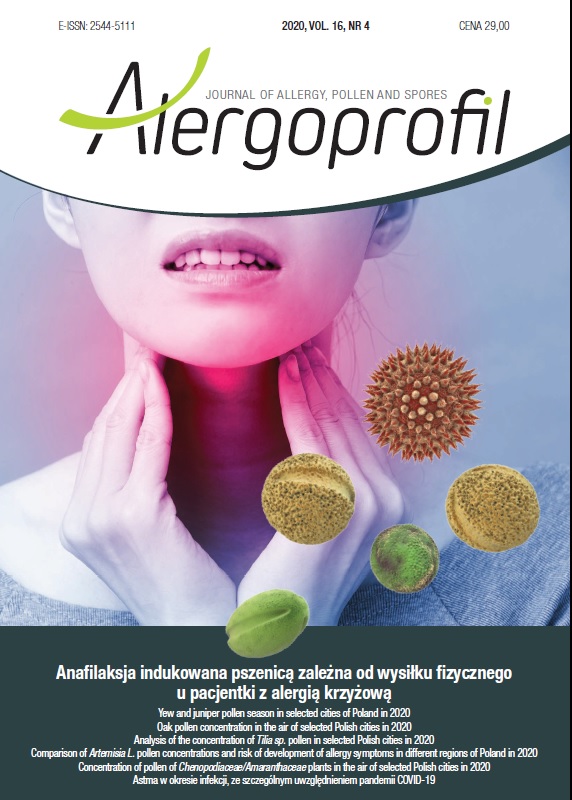Comparison of Artemisia L. pollen concentrations and risk of development of allergy symptoms in different regions of Poland in 2020 Original article
##plugins.themes.bootstrap3.article.main##
Abstrakt
In Central Europe, mugwort pollen is a frequent cause of pollen allergy. Poland is one of the countries with the highest airborne concentrations of pollen of this taxon. Due to its high allergenic potential, Artemisia pollen may pose a significant threat to sensitive subjects during summer months. Plants from this genus often grow in urban and suburban areas.
The aim of the study was to compare mugwort pollen seasons and concentrations of airborne pollen of these plants in 12 cities located in different regions of Poland: Bialystok, Bydgoszcz, Cracow, Lublin, Olsztyn, Opole, Piotrkow Trybunalski, Sosnowiec, Szczecin, Warsaw, Wroclaw, and Zielona Gora. The investigations were carried out with the volumetric method using a Hirst-type pollen sampler (Lanzoni or Burkard) operating on a 24-hour basis. The duration of the pollen season was determined with the 98% method. The earliest onset of the mugwort pollen season was noted in Opole (July 12th), and the latest beginning was recorded in Cracow and Sosnowiec (July 23rd). The maximum pollen concentrations were reported on August 7th and 8th in Lublin (177 grains/m3) and Wroclaw (100 grains/m3). In all the cities, peak days were recorded on the first 10 days of August. The maximum pollen concentrations in the other cities were in the range of 18–89 grains/m3. The highest annual pollen sum was recorded in Lublin (1423) and Wroclaw (1050). These values coincided with the highest pollen concentrations determined in these cities.
The annual Artemisia pollen sums in 2020 did not have the highest values in comparison with other years in these cities. The average annual pollen sum in the five-year period of 2001–2005 was estimated at 2065 in Lublin and 1662 in Wroclaw. Therefore, it can be concluded that the risk of mugwort pollen allergy in the pollen season 2020 was lower than in some previous years.
Pobrania
##plugins.themes.bootstrap3.article.details##

Utwór dostępny jest na licencji Creative Commons Uznanie autorstwa – Użycie niekomercyjne 4.0 Międzynarodowe.
Copyright: © Medical Education sp. z o.o. This is an Open Access article distributed under the terms of the Attribution-NonCommercial 4.0 International (CC BY-NC 4.0). License (https://creativecommons.org/licenses/by-nc/4.0/), allowing third parties to copy and redistribute the material in any medium or format and to remix, transform, and build upon the material, provided the original work is properly cited and states its license.
Address reprint requests to: Medical Education, Marcin Kuźma (marcin.kuzma@mededu.pl)
Bibliografia
2. Majkowska-Wojciechowska B. Pyłek roślin i alergeny sezonowe w Polsce. Alerg Astma Immun 2016; 21(1): 5-15.
3. Tutin TG. Artemisia L. In: Tutin TG, Burges NA, Chater AO et al (ed). Flora Europea (Plantaginaceae to Compositae (and Rubiaceae). Vol. 4. Cambridge University Press Cambridge 1976: 178-86.
4. Szweykowska A, Szweykowski J (ed). Słownik botaniczny. Wiedza Powszechna, Warszawa 2003.
5. D’Amato G, Cecchi L, Bonini S et al. Allergenic pollen and pollen allergy in Europe. Allergy. 2007; 62(9): 976-90.
6. Rutkowski L. Klucz do oznaczania roślin naczyniowych Polski niżowej. 2nd ed. Wydawnictwo Naukowe PWN, Warszawa 2008.
7. Wielgosz T. Wielka księga ziół polskich. Grupa Wydawnicza Publicat S.A., Poznań 2008.
8. Kohlmünzer S. Farmakognozja podręcznik dla studentów farmacji. Wydawnictwo Lekarskie PZWL, Warszawa 2016.
9. Skjøth CA, Šikoparija B, Jäger S; EAN-Network. Pollen sources. In: Sofiev M, Bergmann K-Ch (ed). Allergenic Pollen. Springer, Dordrecht, Heidelberg, New York, London 2013.
10. Weryszko-Chmielewska E, Piotrowska K. Pyłek wybranych taksonów roślin w powietrzu Lublina w latach 2001-2005. In: Weryszko-Chmielewska E (ed). Pyłek roślin w aeroplanktonie różnych regionów Polski. Wydawnictwo Akademii Medycznej, Lublin 2006: 105-15.
11. Rapiejko P, Stankiewicz W, Szczygielski K et al. Progowe stężenie pyłku roślin niezbędne do wywołania objawów alergicznych. Otolaryngol Pol. 2007; 61(4): 591-4.
12. Galán C, Smith M, Thibaudon M et al. Pollen monitoring: Minimum requirements and reproducibility of analysis. Aerobiologia. 2014; 30: 385-95. http://doi.org/10.1007/s10453-014-9335-5.
13. Weryszko-Chmielewska E, Piotrowska K, Chłopek K et al. Analiza sezonów pyłkowych bylicy (Artemisia L.) w wybranych miastach Polski w latach 2001-2005. In: Weryszko-Chmielewska E (ed). Pyłek roślin w aeroplanktonie różnych regionów Polski. Wydawnictwo Akademii Medycznej, Lublin 2006: 133-41.
14. Spieksma FThM, von Wahl PG. Allergenic significance of Artemisia (Mugwort) Pollen. In: D’Amato G, Spieksma FThM, Bonini S (ed). Allergenic pollen and pollinosis in Europe. Blackwell Scientific Publications, Oxford 1991: 121-4.
15. Wolf F, Puls KE, Bergmann KC. A mathematical model for mugwort (Artemisia vulgaris L.) pollen forecasts. Aerobiologia. 1998, 14: 359-73. http://doi.org/10.1007/BF02694305.
16. Bogawski P, Grewling Ł, Frątczak A. Flowering phenology and potential pollen emission of three Artemisia species in relation to airborne pollen data in Poznań (Western Poland). Aerobiologia. 2015; 32: 265-76. http://doi.org/10.1007/s10453-015-9397-z.
17. Cariñanos P, Díaz de la Guardia C, Algarra JA et al. The pollen counts as bioindicator of meteorological trends and tool for assessing the status of endangered species: The case of Artemisia in Sierra Nevada (Spain). Clim Chang. 2013, 119: 799-813. http://doi.org/10.1007/s10584-013-0751-2.
18. Bogawski P, Grewling Ł, Nowak M et al. Trends in atmospheric concentrations of weed pollen in the context of recent climate warming in Poznań (Western Poland). Int J Biometeorol. 2014; 58: 1759-68. http://doi.org/10.1007/s00484-013-0781-5.
19. Clot B. Trends in airborne pollen: an overview of 21 years of data in Neuchâtel (Switzerland). Aerobiologia. 2003, 19: 227-34. http://doi.org/10.1023/B:AERO.0000006572.53105.17.
20. Stach A, García-Mozo H, Prieto-Baena JC et al. Prevalence of Artemisia species pollinosis in western Poland: impact of climate change on aerobiological trends, 1995–2004. J Investig Allergol Clin Immunol. 2007; 17(1): 39-47.
21. Lind T, Ekebom A, Kübler KA et al. Pollen season trends (1973-2013) in Stockholm aera, Sweden. PLoS One. 2016; 11(11):e0166887. http://doi.org/10.1371/journal.pone.0166887.
22. Piotrowska-Weryszko K, Weryszko-Chmielewska E. The airborne pollen calendar for Lublin, central-eastern Poland. Ann Agric Environ Med 2014; 21(3): 487-91. http://doi.org/10.5604/12321966.1120598.
23. Rodinkova VV. Airborne pollen spectrum and hay fever type prevalence in Vinnitsa, central Ukraine. Acta Agrobot. 2015; 68(4): 383-9.
24. Stępalska D, Myszkowska D, Leśkiewicz K et al. Co-occurrence of Artemisia and Ambrosia pollen seasons against the background of the synoptic situations in Poland. Int J Biometeorol. 2017; 61: 747-60. http://doi.org/10.1007/s00484-016-1254-4.

